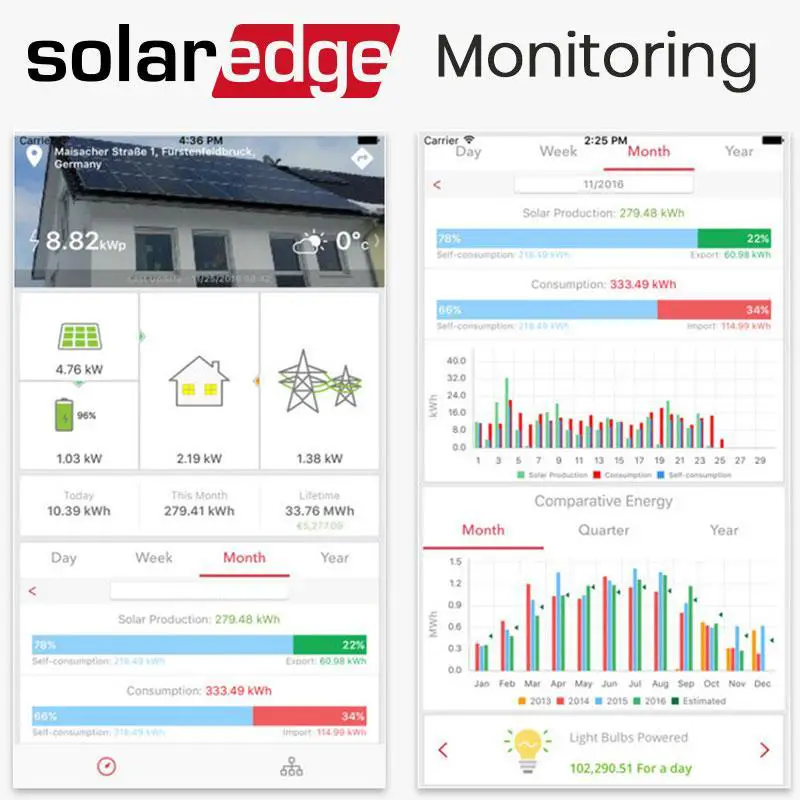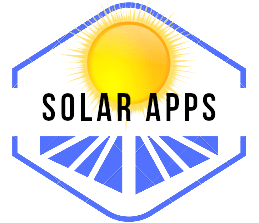SolarEdge Monitoring App the monitoring platform app from SolarEdge presents users with a sleek and user-friendly interface, granting them easy access to various energy production views based on different timeframes like day, week, month, year, or billing cycle. Within the SolarEdge monitoring app, the Dashboard tab captures crucial information, including a customized system photo, location, system size (kW), current weather, and real-time power production. Additionally, a comprehensive graph at the bottom of the app showcases a comparative analysis of energy measurements across three timeframes: month, quarter, and year.

The SolarEdge monitoring app enables remote monitoring for PV installers and system owners on Android devices. Users can access the latest data to maximize solar energy harvesting and stay informed about site performance.
Contents
Importance of SolarEdge Monitoring App:
SolarEdge monitoring app plays a crucial role in enhancing the functionality and efficiency of solar PV systems by providing remote access to system data. This remote monitoring capability is essential for several reasons:
- Performance Optimization: SolarEdge Monitoring allows users to track the performance of individual solar panels, identify underperforming panels, and promptly address issues. This leads to improved energy production and overall system efficiency.
- Issue Detection: The monitoring system provides real-time alerts for any anomalies or malfunctions in the system, such as panel shading, inverter faults, or communication errors. This enables users to quickly identify and address problems, minimizing downtime and lost energy production.
- Data-Driven Decision Making: The data collected through SolarEdge Monitoring offers valuable insights into energy production patterns, consumption, and system health. This information can guide users in making informed decisions about energy usage, potential upgrades, and system maintenance.
- Remote Access: Users can access their solar system’s data through a web portal or a mobile app, enabling remote monitoring and management. This is particularly useful for homeowners, solar installers, and maintenance teams who need to keep tabs on the system’s performance without being physically present.
- Warranty and Support: SolarEdge’s monitoring system helps simplify the warranty claim process. If an issue arises, the monitoring data can serve as evidence, expediting the resolution with the manufacturer or installer.
Uses of SolarEdge Monitoring App:
SolarEdge Monitoring serves several practical purposes, including:
- Real-Time Monitoring: Users can observe their solar system’s real-time energy production, consumption, and overall performance.
- Performance Analysis: Historical data allows users to analyze energy production trends, identify seasonal variations, and assess the impact of weather conditions on system performance.
- Maintenance Planning: Monitoring data helps users schedule maintenance activities, such as cleaning panels, optimizing system configuration, and addressing issues proactively.
- Energy Consumption Insights: The monitoring system can also provide insights into household energy consumption, aiding users in making energy-efficient decisions.
Pros of SolarEdge Monitoring App:
- Detailed Insights: The SolarEdge Monitoring app offers granular data on individual panel performance, helping users identify and address problems swiftly.
- Remote Accessibility: Users can access their solar system’s data from anywhere using a web portal or a mobile app.
- Alerts and Notifications: The system sends alerts and notifications in case of anomalies or issues, allowing for timely intervention.
- Enhanced Efficiency: By identifying underperforming panels and addressing issues promptly, users can optimize their system’s energy production.
- Warranty Support: Monitoring data can be valuable in warranty claims and support discussions.
Cons of SolarEdge Monitoring App:
- Cost: While some basic monitoring features may be included with the initial system purchase, more advanced monitoring features may come at an additional cost.
- Dependence on Technology: The monitoring system relies on technology infrastructure, including an internet connection. Technical glitches or outages could temporarily disrupt monitoring capabilities.
- Complexity: Some users might find the monitoring interface complex, particularly those who are less tech-savvy.
- Privacy Concerns: As with any data-driven technology, there might be privacy concerns related to the collection and storage of energy consumption data.
key Features:
The application offers a comprehensive overview of the system’s performance, allowing users to easily assess its current status. It provides access to both present and past measurements, including:
Current system power. Energy generated today, in the last month, and over the system’s lifetime. Graphical display of daily power production, weekly energy generation, and yearly energy production.
How to Read Solar Edge Monitoring Apps
The app provides real-time monitoring of solar energy production, consumption, and system performance. Please note that there might have been updates or changes to the app since then, so it’s a good idea to consult the latest documentation or user guides provided by SolarEdge for the most accurate information.
Here’s a general guide on how to use the SolarEdge Monitoring app:
Download and Install the App: Search for “SolarEdge Monitoring” on your device’s app store (Google Play Store for Android or Apple App Store for iOS). Download and install the app.
Create or Log In to Your Account: If you already have a SolarEdge monitoring account, log in using your credentials. If you don’t have an account, you might need to create one. Typically, your installer will provide you with the necessary information to set up your account.
Connect Your System: Once you’re logged in, you’ll need to connect your solar power system to the app. This usually involves inputting the details of your SolarEdge system, such as the site ID or serial number. This information can often be found in the documentation provided by your installer.
Dashboard Overview: After connecting your system, you’ll be taken to the app’s dashboard. Here, you’ll see an overview of your solar energy production, consumption, and system performance. You might see real-time data, historical data, and even charts that display how your system is performing.
Energy Production: The app will display how much energy your solar panels are currently producing. You can typically see this in kilowatts (kW) or megawatts (MW), along with a graphical representation of production over time.
Energy Consumption:
Some SolarEdge systems allow you to monitor your energy consumption as well. If your system is set up to monitor consumption, you’ll be able to see how much energy your home is using and possibly even how much is being fed back into the grid.
System Health and Alerts: The app might provide information about the health of your solar system. It could show if there are any issues or if certain components are underperforming. You might also receive alerts if something is wrong with the system.
Historical Data: Many apps allow you to access historical data, allowing you to see how your system has performed over days, weeks, months, or even years.
Settings and Preferences: Explore the app’s settings to customize your experience. You might be able to set up notifications, configure alerts, and adjust your preferences.
Additional Features: Depending on updates and features added since my last update, there could be additional functionalities in the app, such as comparing your system’s performance to other similar systems, exploring energy savings, or learning about the environmental impact of your solar power generation.
Remember that the specifics of using the app can vary based on your system’s configuration and any updates that have occurred since my last knowledge update. If you’re having trouble using the SolarEdge monitoring app or understanding certain features, it’s recommended to refer to the official SolarEdge monitoring app documentation, user guides, or support resources.
Conclusion
In conclusion, the SolarEdge Monitoring app offers numerous advantages, enabling users to optimize the performance of their solar PV systems, detect issues promptly, and make informed decisions based on real-time and historical data. While there are associated costs and potential technical complexities, the benefits often outweigh the drawbacks, making monitoring an essential component of a well-managed solar energy system.
